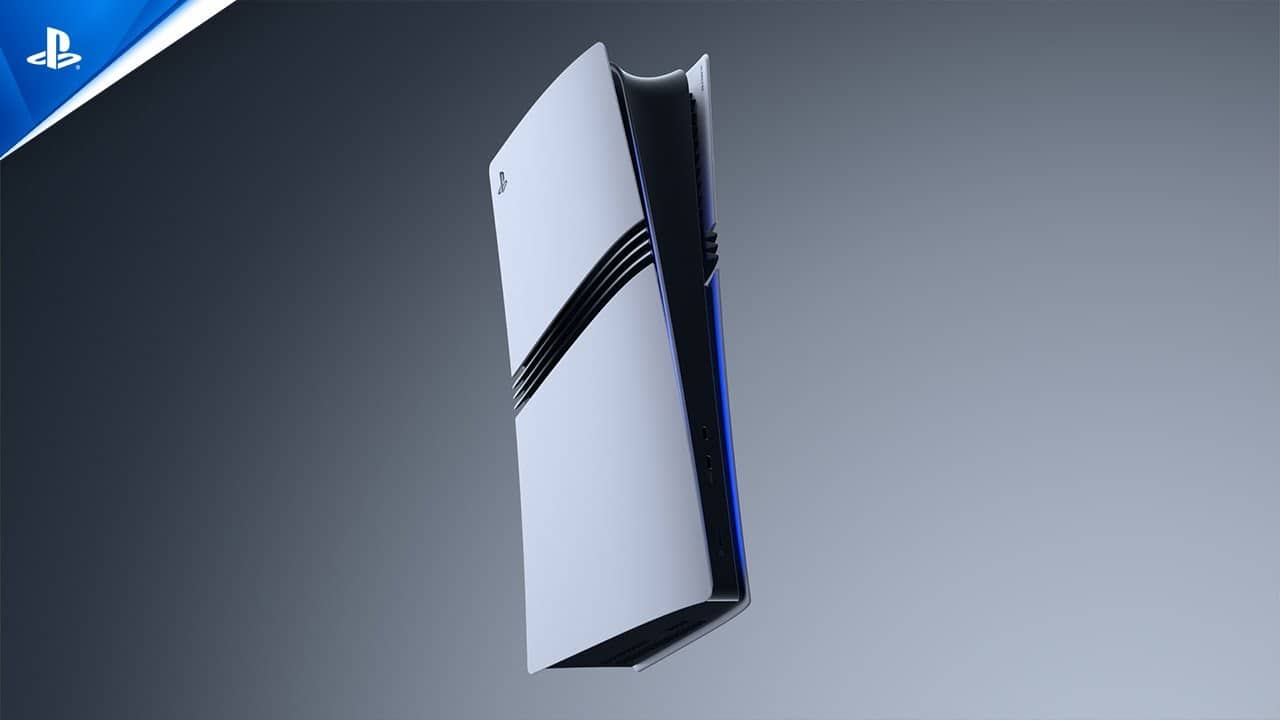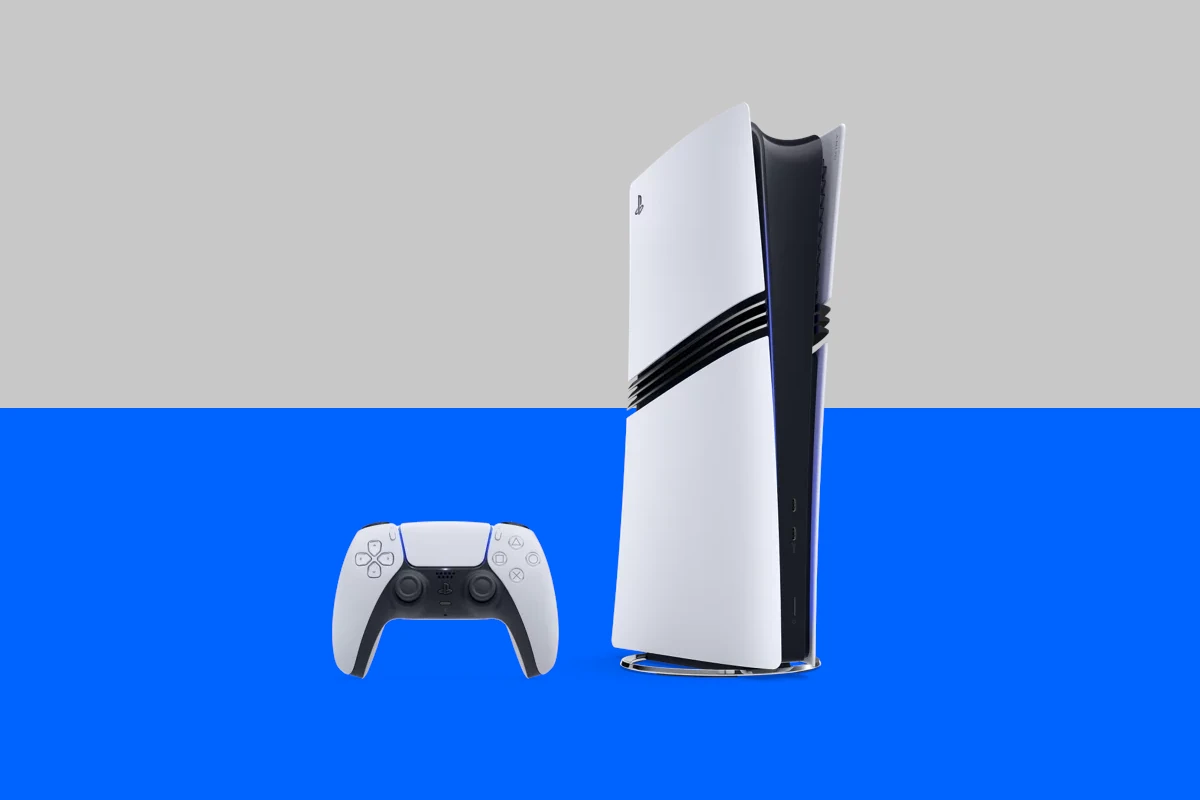The PlayStation 5 Pro represents Sony’s mid-generation upgrade to their flagship console, offering significant performance improvements over the standard PS5. Announced in late 2024, this premium console boasts a GPU with 67 percent more compute units and 28 percent faster memory than the base model. The PS5 Pro delivers a substantial leap in graphical capabilities with 16.7 teraflops of processing power compared to the original PS5’s 10.28 teraflops, making it Sony’s most powerful gaming console to date.
This enhanced hardware translates to meaningful upgrades for gamers, particularly those with high-end displays. The PS5 Pro introduces AI upscaling technology—a first for Sony’s console lineup—allowing games to render at higher effective resolutions while maintaining smooth performance. For the $700 price point, consumers get the discless version of the console with additional storage compared to the base PS5, positioning it as a premium option for enthusiasts seeking cutting-edge performance.
When compared to other current-generation consoles like the Xbox Series X or the standard PS5, the Pro model establishes itself firmly at the top of the performance hierarchy. While more expensive than its competitors, the PS5 Pro targets players who prioritize visual fidelity and technical performance in their gaming experiences, similar to how Sony approached the PS4 Pro release during the previous console generation.
PS5 Pro Specs: What’s Actually New?

The PS5 Pro isn’t just a minor refresh — it’s a serious mid-generation leap aimed at enthusiasts who want better performance, smoother visuals, and more storage. At the heart of the upgrade is a significantly more powerful GPU, featuring 67% more compute units and around 45% faster rendering capabilities compared to the standard PS5. This translates into better performance at native 4K, improved ray tracing support, and even preliminary support for 8K gaming where applicable.
The GPU boost is matched by faster GDDR6 memory, now clocked at 18Gbps, which helps maintain higher frame rates during graphically intensive scenes. Load times also benefit from a bump in SSD capacity — the PS5 Pro includes a 2TB internal SSD, doubling the storage from the base model and surpassing what’s offered in other consoles like the Xbox Series X.
AI Upscaling with PSSR
One of the most innovative features in the PS5 Pro is Sony’s new PlayStation Spectral Super Resolution (PSSR) — an AI-driven upscaling technology. Unlike traditional upscalers, PSSR uses machine learning to dynamically render lower-resolution frames and intelligently upscale them to 4K or even 8K. This allows games to run at higher frame rates while still looking crisp and detailed, making the PS5 Pro feel like it’s punching above its weight class in terms of visual fidelity.
Performance Comparison: PS5 Pro vs Xbox Series X and More
GPU Power & Resolution
The PS5 Pro’s upgraded GPU delivers around 33 teraflops of raw power when accounting for its AI-based upscaling — a noticeable bump over the Xbox Series X’s 12 teraflops. While raw teraflops don’t tell the whole story, early benchmarks suggest the PS5 Pro handles ray tracing and high-resolution rendering more efficiently, especially when PSSR is active.
Games like Spider-Man 2 and Horizon Forbidden West are expected to receive Pro-optimized modes offering 60fps at 4K with ray tracing enabled — something current-gen consoles often have to sacrifice for performance. This could give the PS5 Pro a clear lead in visually demanding games, particularly Sony’s own exclusives.
Storage and Expansion
Out of the box, the PS5 Pro ships with 2TB of storage — double what the Xbox Series X offers and a very welcome upgrade in an age of 100GB+ game installs. The console also maintains support for M.2 SSD expansion, giving players room to grow without relying on slower external drives.
Connectivity and Wi-Fi 7
Another future-proofing feature is Wi-Fi 7 support, offering significantly faster wireless speeds and lower latency. Compared to the Xbox Series X’s Wi-Fi 6, the PS5 Pro has a potential edge for online play and cloud gaming. While most households won’t see immediate benefits, the PS5 Pro is clearly designed to age well as networks evolve.
Design and Physical Media
Physically, the PS5 Pro keeps the sleek design of the new PS5 Slim but drops the optical drive unless you buy it separately. The modular external Blu-ray drive costs an additional $79 and attaches magnetically, making it easy to add physical media support down the line — but it does mean an extra cost up front if you want to play disc-based games or movies.
Power and Cooling
To handle the performance jump, the PS5 Pro features an enhanced cooling system with improved airflow and a slightly redesigned heat sink. Despite the bump in specs, Sony has managed to keep fan noise and thermal output in check — a huge win for gamers tired of jet engine sounds during peak loads.
How It Stacks Up in 2025’s Gaming Landscape
The timing of the PS5 Pro’s release is strategic. With rumors swirling about the next-gen Xbox already in development and Nintendo expected to launch its Switch successor in 2025, Sony is asserting dominance in the high-end console space before the next generational leap. The PS5 Pro doesn’t replace the PS5, but it sets a new standard for premium console gaming with a level of performance that starts to encroach on what high-end gaming PCs offer — but at a much lower cost.
Who Is the PS5 Pro For?
This isn’t a console for everyone. If you’re primarily playing 1080p or 1440p and don’t care about ray tracing or higher frame rates, the standard PS5 is still excellent. But for gamers with 4K TVs, large digital libraries, and a desire for the best visuals Sony can offer, the PS5 Pro is a compelling upgrade — especially if you’re invested in PlayStation exclusives that will be optimized to take full advantage of the hardware.
The Cost of Performance
At $699.99, the PS5 Pro is the most expensive console on the market right now. Add the $79 disc drive and you’re nearing $780 before taxes — not including games, accessories, or a subscription. But for what you’re getting — a powerful GPU, doubled storage, AI upscaling, and forward-looking features — it’s arguably worth it for hardcore gamers who want the best console experience available today.
PS5 Pro vs PS5 vs Xbox Series X
Here’s how the new PS5 Pro measures up against the original PS5 and Xbox Series X.
| Feature | PS5 Pro | PS5 (Standard) | Xbox Series X |
|---|---|---|---|
| Release Date | November 2024 | November 2020 | November 2020 |
| Price | $699.99 | $499.99 | $499.99 |
| GPU Power | ~33 TFLOPS (with AI upscaling) | 10.28 TFLOPS | 12 TFLOPS |
| CPU | 8-core AMD Zen 2 @ 3.5GHz (variable) | 8-core AMD Zen 2 @ 3.5GHz (variable) | 8-core AMD Zen 2 @ 3.8GHz (3.6GHz w/ SMT) |
| RAM | 16GB GDDR6 @ 18Gbps | 16GB GDDR6 @ 14Gbps | 16GB GDDR6 @ 14Gbps |
| Storage | 2TB Custom NVMe SSD | 825GB Custom NVMe SSD | 1TB NVMe SSD |
| Expandable Storage | Yes (M.2 NVMe SSD slot) | Yes (M.2 NVMe SSD slot) | Yes (proprietary expansion card) |
| Ray Tracing | Enhanced hardware-accelerated | Supported | Supported |
| Upscaling Tech | PSSR (AI upscaling) | No | FSR/ML-based (game dependent) |
| Resolution Target | 4K @ 60fps (8K supported) | 4K @ 30–60fps | 4K @ 30–60fps (8K support advertised) |
| Optical Drive | Sold Separately ($79) | Included | Included |
| Wi-Fi Standard | Wi-Fi 7 | Wi-Fi 6 | Wi-Fi 6 |
| Backwards Compatibility | Yes (PS4) | Yes (PS4) | Yes (Xbox One, 360, Original Xbox) |
| Dimensions | Slightly larger than PS5 Slim | 390mm × 104mm × 260mm | 301mm × 151mm × 151mm |
| Exclusive Games | Yes (optimized for Pro) | Yes | Yes |
Key Takeaways
- The PS5 Pro features 67% more compute units and 16.7 teraflops of GPU power compared to the standard PS5’s 10.28 teraflops.
- Sony introduces console AI upscaling with the PS5 Pro, enabling higher effective resolutions not available on the base PS5.
- Priced at $700 for the discless version, the PS5 Pro targets enthusiasts wanting premium performance rather than budget-conscious gamers.
Overview of PlayStation 5 Pro
The PlayStation 5 Pro represents Sony’s mid-generation console upgrade, offering significant performance improvements over the standard PS5. It features enhanced processing power, improved graphics capabilities, and additional storage options designed for more demanding gaming experiences.
Design and Build
The PS5 Pro maintains a similar aesthetic to the original PlayStation 5 but with some distinct differences. The console features the same two-tone color scheme with white panels against a black center, though with subtle design refinements that set it apart from its predecessor.
In terms of dimensions, the Pro model is comparable to the standard PS5, making it a substantial piece of hardware that requires adequate space in an entertainment setup. Sony has retained the vertical orientation option, though the console can also be positioned horizontally with the included stand.
The front panel includes a disc drive on the standard edition (a digital-only version is not currently available), USB ports, and power buttons. Cooling vents are strategically placed to manage the increased thermal output from the more powerful components inside.
Hardware Upgrades
The PS5 Pro delivers substantial performance improvements over the standard PS5. It features an enhanced GPU with approximately 45% more compute units, allowing for smoother gameplay and higher frame rates in demanding titles.
One of the most significant additions is PlayStation Spectral Super Resolution (PSSR), Sony’s AI-powered upscaling technology. This feature allows games to render at lower resolutions and then be upscaled to 4K, resulting in sharper images while maintaining performance.
The console also offers improved ray tracing capabilities, with up to 3x better performance in ray-traced scenes compared to the standard PS5. This translates to more realistic lighting, reflections, and shadows in compatible games.
The CPU has been optimized for better performance while maintaining compatibility with the existing PS5 game library. These improvements collectively enable more consistent 60fps gameplay even in graphically intensive titles.
Storage Capacity
The PS5 Pro comes equipped with a 2TB SSD, a significant upgrade from the 825GB SSD found in the original PS5. This increased storage capacity addresses one of the most common complaints about the base model, providing more space for today’s increasingly large game installations.
Game files continue to grow in size, with many AAA titles now exceeding 100GB, making the expanded storage a welcome improvement. The 2TB capacity allows players to keep more games installed simultaneously without constantly managing their storage.
The PS5 Pro retains the expansion slot for compatible M.2 SSDs, giving users the option to further increase their storage capacity if needed. This flexibility lets players tailor their storage solution to their specific needs.
The high-speed SSD continues to deliver the near-instantaneous loading times that defined the PS5 generation, with the increased capacity now supporting a larger game library.
Backward Compatibility
The PS5 Pro maintains full backward compatibility with the PlayStation 5 game library, ensuring players can enjoy their existing collection with enhanced performance. Many games will automatically benefit from the improved hardware even without specific optimization.
For PS4 titles, the backward compatibility continues to work as it did on the standard PS5. Selected games receive performance boosts through Game Boost, offering higher and more stable frame rates.
Developers have the option to release PS5 Pro patches for their games, enabling specific enhancements that take full advantage of the upgraded hardware. Several games have already received these updates, with more expected to follow.
The console’s backward compatibility extends to PlayStation VR and PlayStation VR2 titles, maintaining Sony’s commitment to supporting virtual reality gaming across their ecosystem.
Technical Specifications
The PlayStation 5 Pro brings significant hardware improvements over the standard PS5, focusing on enhancing graphical capabilities and processing power. Sony has integrated several next-generation technologies to push console gaming forward.
CPU and GPU Enhancements
The PS5 Pro retains the same CPU as the standard PS5 but features a substantially upgraded GPU. While the base PS5 utilizes 36 compute units, the Pro version reportedly increases this number significantly. According to search results, the PS5 Pro’s GPU performance may reach around 33.5 TFLOPs, though Sony hasn’t officially confirmed this specific number.
This represents a major leap from the original PS5’s capabilities. The enhanced GPU architecture allows the console to handle more complex graphical workloads with greater efficiency.
The memory system has also been improved to support these enhancements, providing faster data transfer speeds necessary for the improved visuals.
Fidelity and Performance Modes
The PS5 Pro introduces refined performance options that give players more control over their gaming experience. Fidelity Mode prioritizes visual quality, enabling games to run at higher resolutions with enhanced graphical effects while maintaining acceptable framerates.
Performance Mode, on the other hand, focuses on delivering smoother gameplay with higher framerates, typically targeting 60fps or higher while making some compromises to visual fidelity.
Some games on PS5 Pro will support both 4K resolution and 60fps simultaneously—something that often required compromise on the standard PS5. The enhanced hardware enables developers to offer more consistent performance across both modes.
AI-Powered Upscaling and Ray Tracing
One of the PS5 Pro’s most innovative features is its AI-powered upscaling technology, similar in concept to NVIDIA’s DLSS. This system intelligently enhances lower-resolution images to appear nearly identical to native high-resolution output while requiring less processing power.
Ray tracing performance has seen substantial improvements on the PS5 Pro. The enhanced GPU architecture handles ray-traced lighting effects more efficiently, allowing for more realistic reflections, shadows, and global illumination without the same performance penalties seen on the standard PS5.
These improvements enable developers to implement more advanced lighting techniques in their games while maintaining playable framerates. Games that struggled with ray tracing on the original PS5 should perform noticeably better on the Pro model.
Gaming Experience
The PlayStation 5 Pro delivers significant improvements to the overall gaming experience compared to the standard PS5 and other consoles on the market. The enhancements in performance, visual quality, and specialized technologies create a premium experience for dedicated gamers.
Enhanced Performance and Frame Rates
The PS5 Pro features a custom-designed AMD Zen 3 processor that operates at higher clock speeds than the base PS5 model. This upgrade provides improved processing power for more complex game calculations and smoother overall performance.
The Pro model’s GPU offers 16.7 TFLOPs of power, a substantial leap from the original PS5’s 10.3 TFLOPs. This boost in graphical processing enables games to run with better framerates across various visual modes.
For performance-focused gamers, the PS5 Pro eliminates many of the compromises present in the standard model. Players no longer need to choose between visual quality and smooth performance in demanding titles.
Many games that previously struggled to maintain 60 FPS on the base PS5 can now do so consistently on the Pro, even with enhanced visual settings. This makes fast-paced action games and competitive titles feel more responsive and fluid.
Visual Fidelity and Graphics
The PS5 Pro pushes the boundaries of console graphics with enhanced rendering capabilities. Games display more detailed textures, improved lighting effects, and greater visual clarity across different display modes.
Players with modern TVs will particularly benefit from the Pro’s capabilities. The console supports gaming at up to 8K resolution, compared to the standard PS5’s 4K limit, though the actual implementation varies by game.
Ray tracing performance sees a notable improvement on the PS5 Pro. Games with ray-traced reflections, shadows, and global illumination run more smoothly without the significant framerate penalties experienced on the base model.
HDR implementation is also enhanced, providing more vibrant colors and better contrast in supported games. This creates more lifelike and immersive visual presentations across compatible titles.
PlayStation Spectral Super Resolution
The PS5 Pro introduces PlayStation Spectral Super Resolution (PSSR), an AI-powered upscaling technology not available on the standard PS5. This advanced feature intelligently enhances lower-resolution images to appear sharper and more detailed.
PSSR works similarly to NVIDIA’s DLSS or AMD’s FSR technologies, allowing games to render at lower internal resolutions while still looking crisp on high-resolution displays. This technique preserves performance while maintaining visual quality.
The AI backbone of PSSR analyzes game scenes to add appropriate detail where needed. This results in cleaner edges, sharper textures, and reduced visual artifacts compared to traditional upscaling methods.
Games that implement PSSR can offer both higher framerates and improved visual fidelity simultaneously. This technology represents one of the most significant advances in the PS5 Pro’s gaming experience compared to other consoles.
Comparative Analysis to Other Consoles
The PlayStation 5 Pro introduces significant hardware upgrades that position it differently in the console market. These improvements come with a higher price point that affects its comparative value against other gaming options.
PlayStation 5 vs PlayStation 5 Pro
The PS5 Pro represents a substantial upgrade over the standard PlayStation 5, justifying its premium price for certain gamers. The Pro model features a GPU that delivers 45% faster rendering, providing a noticeable performance boost in graphically demanding games.
One of the PS5 Pro’s most significant advantages is its enhanced ray tracing capabilities, which create more realistic lighting and reflections. This feature particularly benefits games designed to showcase next-generation visuals.
The Pro model introduces PlayStation Spectral Super Resolution (PSSR), an AI-driven upscaling technology that improves image quality. This allows games to run at higher effective resolutions without sacrificing performance.
Price difference is considerable, with the PS5 Pro costing $699.99/£699.99 compared to the standard PS5’s $499.99/£479.99. This represents a 40-45% price increase for the premium model.
The Pro remains discless by default, continuing Sony’s push toward digital game distribution.
PS5 Pro vs Xbox Series X
When comparing the PS5 Pro to Microsoft’s flagship Xbox Series X, Sony’s premium console now holds a clear technical advantage. The upgraded GPU and specialized ray tracing hardware give the Pro an edge in rendering complex scenes.
The PS5 Pro’s PSSR technology provides similar benefits to Xbox’s upscaling methods but potentially with better results in supported games. This could create noticeable visual differences between multiplatform titles.
Sony’s exclusives optimized for PS5 Pro will likely showcase the largest performance gap between the platforms. Games designed specifically to utilize the Pro’s enhanced capabilities will demonstrate its technical superiority.
The value proposition differs significantly. At $699.99, the PS5 Pro costs substantially more than the Xbox Series X’s typical $499.99 price point. This $200 difference makes the Xbox a more budget-friendly option for players less concerned with cutting-edge graphics.
PS5 Pro vs Gaming PC
The PS5 Pro narrows but doesn’t close the gap with mid-to-high-end gaming PCs. A comparable PC with similar ray tracing capabilities would likely cost significantly more than the Pro’s $699.99 price tag.
The Pro offers a streamlined experience with games optimized specifically for its hardware. This eliminates the need for configuration and troubleshooting that PC gaming often requires.
PC gaming still maintains advantages in flexibility and upgradeability. While the PS5 Pro represents a fixed point in hardware that will eventually become outdated, PCs can receive component upgrades over time.
Performance Comparison:
- PS5 Pro: Fixed but highly optimized hardware with excellent ray tracing and AI upscaling
- Gaming PC: Potentially higher performance ceiling but at significantly higher cost
- Upgrade Path: Limited for PS5 Pro vs infinite for PC
PC gamers benefit from broader input options, mod support, and typically lower game prices during sales, offsetting the higher initial hardware investment.
Innovative Features and Future-Proofing
The PlayStation 5 Pro represents a significant technological leap designed to handle increasingly demanding games and extend the console’s relevance in the market. Sony has implemented several forward-thinking features that aim to keep the system viable for years to come.
Connectivity Advancements
The PS5 Pro offers upgraded connectivity options that enhance the overall gaming experience. It features more robust USB ports that provide faster data transfer rates and improved charging capabilities for controllers and accessories. This improvement allows gamers to connect multiple devices simultaneously without performance degradation.
The system supports the latest Wi-Fi technologies, with rumors pointing to potential Wi-Fi 7 compatibility in newer models. This advancement delivers significantly faster download speeds and more reliable connections for online gaming and content streaming.
Bluetooth capabilities have also been enhanced, providing more stable connections with the DualSense controller and third-party peripherals. These connectivity improvements work together to create a seamless gaming ecosystem that responds quickly to user inputs and network demands.
Disc Drive and Digital Edition Considerations
Sony offers the PS5 Pro in both disc-compatible and digital-only configurations, giving consumers flexibility based on their gaming preferences. The disc version includes an Ultra HD Blu-ray drive that supports physical game discs and movie playback at 4K resolution.
The Digital Edition foregoes the optical drive in favor of a sleeker design and slightly lower price point. Both versions provide identical performance specifications, with the only difference being physical media support.
For collectors and those with extensive physical game libraries, the disc version offers valuable backward compatibility with PS4 titles. Digital-only gamers benefit from the convenience of instant downloads and a less cluttered gaming space.
The detachable disc drive option represents an innovative approach that allows Digital Edition owners to add disc functionality later if their needs change.
Mid-Generation Refresh and Its Impact
As a mid-generation refresh, the PS5 Pro builds upon the foundation established by the base PS5 while delivering substantial performance improvements. This strategy extends the PlayStation 5 platform’s lifespan without requiring developers to create entirely new game engines.
The upgraded hardware offers developers more power to enhance existing titles through patches and optimize future releases. Games can now run with improved frame rates, higher resolutions, and more advanced visual effects without compromising performance.
This approach to future-proofing means PS5 Pro owners can expect a steady stream of enhanced games over the next several years. The console’s additional processing power makes it better equipped to handle graphically intensive upcoming titles that might strain the capabilities of the standard PS5.
Developers have already begun implementing PS5 Pro enhancement patches for popular games, demonstrating the system’s ability to breathe new life into existing content.
Pricing and Value Proposition
The PlayStation 5 Pro enters the market with a premium price point that has sparked significant discussion among gamers. At $700, it represents one of the highest-priced console offerings while promising substantial performance improvements over the base PS5 model.
Cost Analysis
The PS5 Pro’s $700 price tag positions it at a considerably higher price point than the standard PS5, which retails for $499.99 (Standard Edition) and $399.99 (Digital Edition). This $200-300 premium represents a significant investment for consumers considering an upgrade.
When compared to previous mid-generation upgrades, the price difference is more pronounced. The PS4 Pro offered a more modest price increase over its base model. Adjusted for inflation, the PS5 Pro stands as one of the most expensive PlayStation consoles at launch.
However, the PS5 Pro still remains more affordable than most high-end gaming PCs with comparable graphical capabilities. This positions it in a unique market segment between traditional consoles and gaming computers.
Long-Term Value Assessment
The PS5 Pro’s value proposition centers on its enhanced hardware specifications and performance improvements. The console offers upgraded graphics processing capabilities specifically designed for 4K gaming with improved frame rates.
Unlike the PS4 Pro, which coincided with the widespread adoption of 4K TVs, the PS5 Pro’s timing doesn’t align with a similar technological shift in consumer displays. This potentially weakens its immediate value proposition for some users.
For hardcore gamers who prioritize performance, the PS5 Pro offers tangible benefits through its performance mode options. Games that take full advantage of the hardware upgrades will provide a noticeably superior experience compared to the base PS5 model.
The long-term value will largely depend on how developers optimize future titles for the Pro hardware and how long before the next full console generation arrives.
Frequently Asked Questions
The PlayStation 5 Pro delivers significant upgrades over the standard PS5 with enhanced graphics capabilities, faster performance, and exclusive features that set it apart from competitors. These improvements target gamers seeking premium experiences on high-end displays.
What enhancements are featured in the PS5 Pro compared to the original PS5?
The PS5 Pro boasts a larger GPU that delivers substantially more processing power than the standard PS5. This upgrade enables more complex game worlds and smoother performance in graphically demanding titles.
The Pro version also features advanced ray tracing capabilities, allowing for more realistic lighting, reflections, and shadows than the base model. This technology creates more immersive gaming environments with light behavior that more closely mimics real-world physics.
Another key enhancement is the addition of PSSR (PlayStation Spectral Super Resolution), an AI-driven upscaling technology exclusive to the Pro. This feature can render games at lower resolutions and intelligently upscale them to 4K, maintaining visual quality while improving performance.
In what ways does the PS5 Pro’s performance surpass that of the Xbox Series X?
The PS5 Pro’s enhanced GPU provides greater raw graphical processing power than the Xbox Series X, particularly evident in ray-tracing performance where the Pro shows measurable advantages in compatible titles.
The PSSR upscaling technology gives the PS5 Pro an edge in resolution handling, delivering sharper images at higher framerates than what’s currently possible on the Xbox Series X. This difference becomes more noticeable when playing at 4K resolution.
Sony’s focus on specialized hardware acceleration for certain graphical features allows the PS5 Pro to excel in specific visual aspects that differentiate its performance profile from Microsoft’s flagship console.
How do the graphics capabilities of the PS5 Pro differ from its predecessor?
The PS5 Pro implements enhanced ray tracing hardware that delivers up to three times better performance in this area compared to the standard PS5. This allows for more realistic lighting, reflections, and shadows without the severe performance penalties typically associated with ray tracing.
The Pro’s GPU contains approximately 67% more compute units than the base PS5, enabling higher framerates at 4K resolution. Games that struggled to maintain 60fps on the original PS5 can now do so consistently on the Pro model.
The addition of PSSR AI upscaling technology represents a significant leap forward not present in the original PS5. This feature intelligently enhances lower-resolution images to near-native 4K quality while maintaining performance.
What exclusive features does the PS5 Pro offer to gamers?
The PS5 Pro introduces PSSR (PlayStation Spectral Super Resolution), an exclusive AI-powered upscaling technology not available on any other console. This feature intelligently enhances image quality while maintaining high performance levels.
Enhanced ray tracing capabilities on the Pro model allow for more realistic lighting effects, giving compatible games a visual advantage not possible on the standard PS5. This technology creates more immersive gaming environments with improved reflections and shadows.
The Pro includes improved cooling technology that allows the system to run quieter than the original PS5, even during graphically intensive gameplay sessions. This enhancement provides a better gaming experience by reducing distracting fan noise.
How do the loading times of the PS5 Pro compare to those of other next-generation gaming consoles?
The PS5 Pro maintains the same high-speed SSD architecture as the original PS5, which already offered industry-leading loading times. Games typically load within seconds, virtually eliminating long wait times between gameplay sessions.
When compared to the Xbox Series X, loading performance remains competitive, with both systems leveraging custom SSD solutions. The difference in loading times between these platforms is often minimal and varies by specific game optimization.
The increased processing power of the PS5 Pro can provide slight advantages in data decompression speed, potentially resulting in marginally faster asset streaming in open-world games compared to other consoles.
Is there a noticeable difference in the virtual reality experiences offered by the PS5 Pro as opposed to other platforms?
The PS5 Pro’s enhanced GPU provides more consistent framerates for PlayStation VR2 titles, which is crucial for comfortable VR experiences. Higher, more stable framerates reduce motion sickness and create more immersive virtual worlds.
Ray tracing improvements on the PS5 Pro translate to more realistic lighting in VR environments, adding depth and believability to virtual spaces that isn’t possible on the standard PS5 or competitor platforms.
The Pro’s additional processing power allows developers to create more detailed VR worlds with higher polygon counts and more complex physics interactions. This leads to richer, more interactive VR experiences than what’s possible on other consoles.







